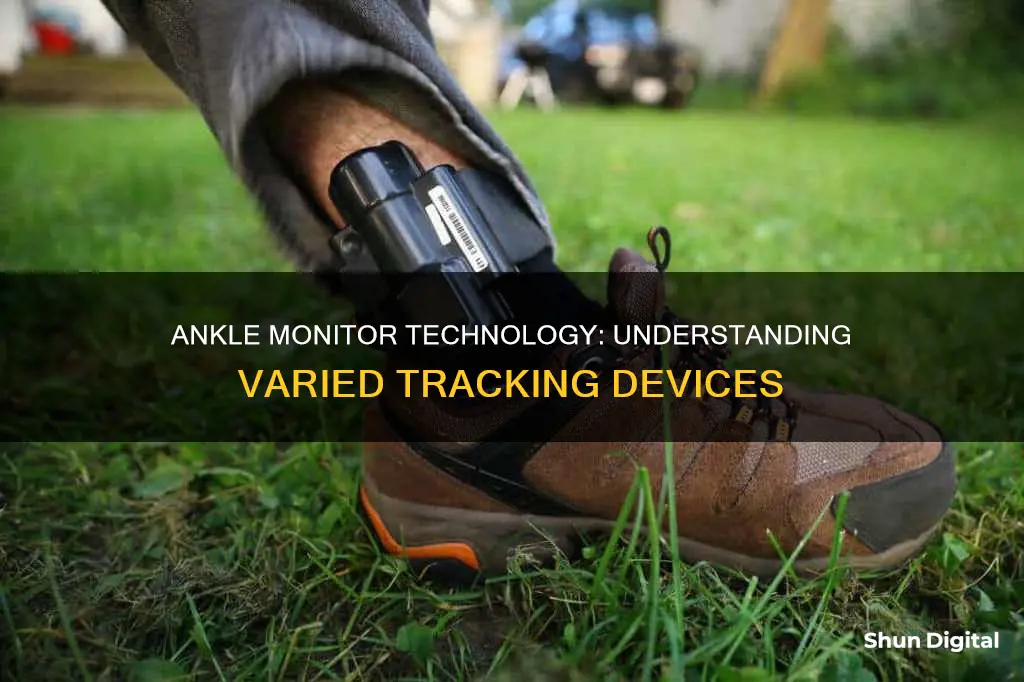
Ankle monitors are an alternative to imprisonment, allowing individuals to serve their sentences while remaining in the community. They are typically used for people on probation or parole, or those awaiting trial. Ankle monitors track an individual’s movements and location using GPS technology, radio frequency, or cellular signal. There are several types of ankle monitors, including radio frequency monitors, global positioning system (GPS) monitors, and secure remote continuous alcohol monitoring systems. Radio frequency monitors notify authorities when an individual enters or deviates from a designated location and are commonly used in curfew and house arrest cases. GPS monitors, on the other hand, provide more precise location data and are used for individuals who are allowed to travel with a pre-arranged schedule. Alcohol monitoring systems detect alcohol consumption levels and forward the data to monitoring agencies.
| Characteristics | Values |
|---|---|
| Purpose | Track individuals under the supervision of the criminal justice system |
| Who are they for? | People on probation or parole, those awaiting trial, or those convicted of a crime but considered low-risk |
| How do they work? | Devices are worn around the ankle and track movement and location using GPS technology |
| Advantages | Less expensive than imprisonment, allow individuals to maintain jobs and support families, facilitate reintegration into society |
| Disadvantages | Can be uncomfortable and cause skin irritation, strict rules and regulations, additional penalties for violations |
| Types | Radio frequency monitors, global positioning system (GPS) monitors, secure remote continuous alcohol monitoring system |
What You'll Learn

Radio frequency monitors
Radio frequency (RF) ankle monitors are a type of electronic monitoring device that utilizes radio frequency technology to track an individual's whereabouts and ensure compliance with court-ordered restrictions. These monitors are typically used for house arrest or curfew cases and do not provide an exact location of the individual. Instead, they notify authorities when the wearer enters or deviates from a designated location, such as their home.
The RF ankle monitor communicates with a receiver installed in the individual's home or another designated location. This receiver acts as a base station for monitoring and data transmission. When the individual wearing the ankle monitor moves outside a certain range, the receiver detects this unauthorized distance and triggers an alert, notifying the appropriate authorities of a potential violation. This technology ensures monitoring even in locations where GPS signals might be weaker or obstructed.
The RF ankle monitor is typically locked into place to prevent tampering and ensure ongoing, accurate monitoring. It is designed to be tamper-proof and will send an alert if any unauthorized movement or tampering is detected, such as attempts to remove or disable the device.
In addition to tracking location, RF ankle monitors can also have other features such as exclusion zones and inclusion zones. Authorities can set up exclusion zones, which are areas that the individual is not allowed to enter. If the wearer enters these zones, the device sends an alert. Inclusion zones, on the other hand, are areas where the individual must remain during specific times.
The use of RF ankle monitors provides an alternative to traditional incarceration, allowing individuals to remain in their communities while being monitored. This is particularly beneficial for non-violent offenders, as it allows them to maintain employment, support their families, and participate in rehabilitative programs.
Removing LED Strips: A Monitor Makeover Guide
You may want to see also

Global positioning system (GPS) monitors
The GPS ankle monitor consists of several key components, including a GPS module, a cellular module for data transmission, and an electronic strap for secure attachment. Accompanying the hardware is a software system that manages data collection and analysis, processing location data received from satellites and generating reports or alerts for law enforcement personnel.
GPS ankle monitors are often used for house arrest, probation, and parole. They help law enforcement ensure that the wearer remains within the physical boundaries of their probation. These monitors can be customized for each wearer, controlling the travel radius according to their confinement conditions. For example, sex offenders cannot approach children's schools without the GPS monitor sounding an alarm.
GPS ankle monitors are designed to be tamper-proof, shock-resistant, and waterproof. They are affixed to the wearer's ankle 24 hours a day, and the wearer is responsible for charging the device regularly. The battery life can vary depending on the device and usage, but it is generally sufficient for ongoing monitoring without frequent recharging.
In addition to location tracking, GPS ankle monitors may also have features such as voice communication, alcohol detection, and curfew monitoring. The use of GPS technology in ankle monitors has proven to be beneficial by reducing jail overcrowding, costs, and promoting rehabilitation and reintegration into society.
Get Rid of Black Spots on Your Monitor
You may want to see also

Secure remote continuous alcohol monitoring systems
Secure Remote Continuous Alcohol Monitoring (SCRAM) systems are ankle monitors used to detect alcohol consumption in offenders who are not supposed to be drinking. They are most commonly used in cases where the defendant has been convicted of driving under the influence (DUI), but they are also used in other cases involving substance abuse, such as family court, domestic violence, and underage drinking.
SCRAM bracelets monitor the wearer's perspiration every 30 minutes, as a certain amount of alcohol is metabolized and emitted as sweat through the skin. The bracelets are equipped with GPS locators and used for offenders on house arrest, allowing courts and probation departments to monitor the offender's location and ensure they don't violate the terms of their house arrest.
The data from SCRAM bracelets is uploaded via modem and monitored by a private company, which reports any positive tests for alcohol to the court. This technology has been proven to support long-term behaviour change and increase compliance with court orders and community safety.
SCRAM bracelets are usually worn 24/7 for a set period, often 60 or 90 days, but they can also be worn for a year or longer as a term of probation or parole. Offenders who attempt to remove or tamper with the bracelet will be reported to the court or probation department, and this can lead to severe consequences such as termination of probation or jail time.
Removing Pip Monitors: A Step-by-Step Guide
You may want to see also

Ankle monitors as an alternative to prison
Ankle monitors are increasingly being used as an alternative to traditional imprisonment, allowing individuals to serve their sentences while remaining in the community. They are typically used for people on probation or parole, those awaiting trial, or those convicted of a crime but considered low-risk. Ankle monitors allow individuals to maintain their jobs, continue their education, and support their families, which can aid in their reintegration into society.
There are several types of ankle monitors, all with GPS functionality to track an individual's movements and location. Some also have additional features such as voice communication, alcohol detection, and curfew monitoring. The first type is radio frequency monitors, which notify authorities when the wearer enters or deviates from a designated location. These are commonly used for curfew and house arrest. The second type is global positioning system (GPS) monitors, which provide more precise location data and are used for offenders who are allowed to travel according to a pre-arranged schedule. They can also be used to restrict certain offenders from approaching specific people or places, such as sex offenders who cannot go near children's schools. The third type is a secure remote continuous alcohol monitoring system, primarily aimed at detecting alcohol consumption levels and forwarding the data to monitoring agencies.
While ankle monitors offer advantages, there are also concerns about their effectiveness and impact on civil liberties. Critics argue that ankle monitors can be uncomfortable, cause skin irritation, and lead to social isolation and stigma. Additionally, the strict rules associated with ankle monitors can be challenging to adhere to, and any violation may result in penalties or imprisonment. The cost of renting ankle monitors can also be a significant financial burden, with fees ranging from $2 to $25 per day in some cases.
Despite these concerns, ankle monitors can be a viable alternative to incarceration in certain situations, particularly when addressing prison overcrowding and providing a chance for eligible offenders to rebuild their lives. However, it is essential to use them with discretion, considering the offender's risk of recidivism and the nature of the crime.
ASUS LCD Monitor Warranty Periods in the USA
You may want to see also

Types of GPS monitoring ankle bracelets
In the United States, prisons are often overcrowded, leading to violence, a lack of healthcare, reduced reform opportunities, and restricted visits. This problem was exacerbated by the COVID-19 pandemic, as many prisons were operating at full capacity. As a result, some jurisdictions began to look for alternatives to incarceration, such as electronic monitoring.
GPS monitoring ankle bracelets are devices used to track offenders and restrict their movements. They are typically used for house arrest, probation, and parole, but each device can be customized for each offender, controlling the travel radius according to the offender’s confinement conditions.
There are several different types of GPS monitoring ankle bracelets, including:
- Radio frequency monitors: These monitors do not provide the wearer’s exact location but notify authorities when the wearer enters or deviates from a designated location. Radio frequency monitors are most commonly used in curfew and house arrest cases, and the wearer must be in a specific location at a specific time.
- Global positioning system (GPS) monitors: These monitors are more precise and can relay location data according to specified intervals or continuously. They are usually used for offenders who are allowed to travel and have a pre-arranged schedule. GPS monitors are also used to restrict certain offenders from getting close to specific people or places, such as sex offenders who cannot get close to children’s schools.
- Secure remote continuous alcohol monitoring system: While this system can relay location data, it is primarily aimed at detecting alcohol consumption levels. It does this by monitoring alcohol test sweat regularly and forwarding the data to monitoring agencies.
Syncing Wireless Keyboards to Monitors: A Step-by-Step Guide
You may want to see also
Frequently asked questions
There are three main types of ankle monitors: radio frequency monitors, global positioning system (GPS) monitors, and secure remote continuous alcohol monitoring systems.
Radio frequency monitors do not provide the exact location of the wearer but notify authorities when the wearer enters or deviates from a designated location. They are most commonly used in curfew and house arrest cases, with the wearer required to be in a specific location at a specific time.
GPS monitors are more precise and can relay location data according to specified intervals or continuously. They are usually used for offenders who are allowed to travel and have a pre-arranged schedule. They can also be employed to restrict certain offenders from getting close to specific people or places, such as sex offenders who cannot get near children's schools.
Yes, there are other types of monitoring systems beyond ankle monitors. These include landline or cellular unit receivers, voice recognition systems, and virtual monitoring using smartphone applications.







